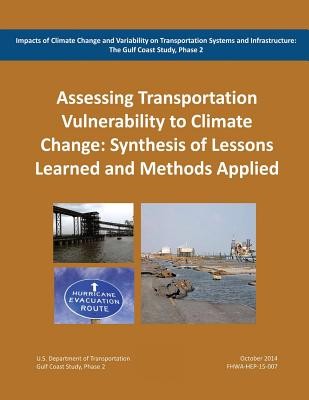
- We will send in 10–14 business days.
- Author: Federal Highway Administration
- Publisher: CreateSpace Independent Publishing Platform
- Year: 2015
- Pages: 48
- ISBN-10: 1507885725
- ISBN-13: 9781507885727
- Format: 21.6 x 28 x 0.3 cm, softcover
- Language: English
- SAVE -10% with code: EXTRA
Impacts of Climate Change and Variability on Transportation Systems and Infrastructure (e-book) (used book) | bookbook.eu
Reviews
Description
The U.S. Department of Transportation conducted a comprehensive, multi-phase study of the Central Gulf Coast region to better understand climate change impacts on transportation infrastructure and identify potential adaptation strategies. This region is home to a complex multimodal network of transportation infrastructure, and it plays a critical economic role in the import and export of oil and gas, agricultural products, and other goods. Phase 1 of this Gulf Coast Study examined the impacts of climate change on transportation infrastructure at a regional scale. Phase 2 focused on a smaller region, enhancing regional decision makers' ability to understand potential impacts on specific components of infrastructure and to evaluate adaptation options. An important goal of Phase 2 was to develop methodologies that could be used by other transportation agencies to evaluate vulnerability and adaptation measures. With that goal in mind, the project team developed transferrable methodologies and pilot tested them on the transportation system in Mobile, Alabama. This study evaluated the impacts on six transportation modes (highways, ports, airports, rails, transit, and pipelines) from projected changes in temperature and precipitation, sea level rise, and the storm surges and winds associated with more intense storms. The project resulted in findings in Mobile's transportation vulnerability, as well as approaches for using climate data in transportation vulnerability assessments, methods for evaluating vulnerability and adaptation options, and tools and resources that will assist other agencies in conducting similar work.
EXTRA 10 % discount with code: EXTRA
The promotion ends in 19d.21:32:19
The discount code is valid when purchasing from 10 €. Discounts do not stack.
- Author: Federal Highway Administration
- Publisher: CreateSpace Independent Publishing Platform
- Year: 2015
- Pages: 48
- ISBN-10: 1507885725
- ISBN-13: 9781507885727
- Format: 21.6 x 28 x 0.3 cm, softcover
- Language: English English
The U.S. Department of Transportation conducted a comprehensive, multi-phase study of the Central Gulf Coast region to better understand climate change impacts on transportation infrastructure and identify potential adaptation strategies. This region is home to a complex multimodal network of transportation infrastructure, and it plays a critical economic role in the import and export of oil and gas, agricultural products, and other goods. Phase 1 of this Gulf Coast Study examined the impacts of climate change on transportation infrastructure at a regional scale. Phase 2 focused on a smaller region, enhancing regional decision makers' ability to understand potential impacts on specific components of infrastructure and to evaluate adaptation options. An important goal of Phase 2 was to develop methodologies that could be used by other transportation agencies to evaluate vulnerability and adaptation measures. With that goal in mind, the project team developed transferrable methodologies and pilot tested them on the transportation system in Mobile, Alabama. This study evaluated the impacts on six transportation modes (highways, ports, airports, rails, transit, and pipelines) from projected changes in temperature and precipitation, sea level rise, and the storm surges and winds associated with more intense storms. The project resulted in findings in Mobile's transportation vulnerability, as well as approaches for using climate data in transportation vulnerability assessments, methods for evaluating vulnerability and adaptation options, and tools and resources that will assist other agencies in conducting similar work.


Reviews